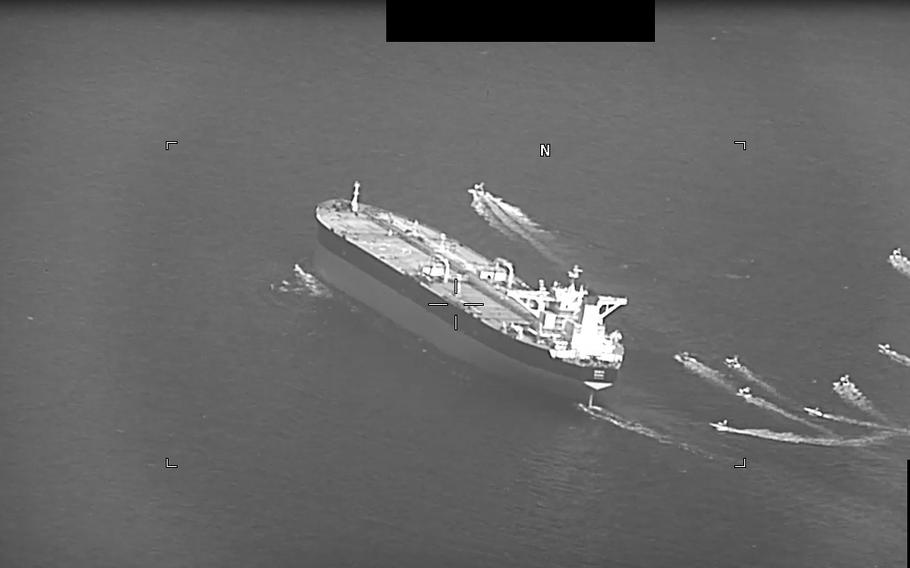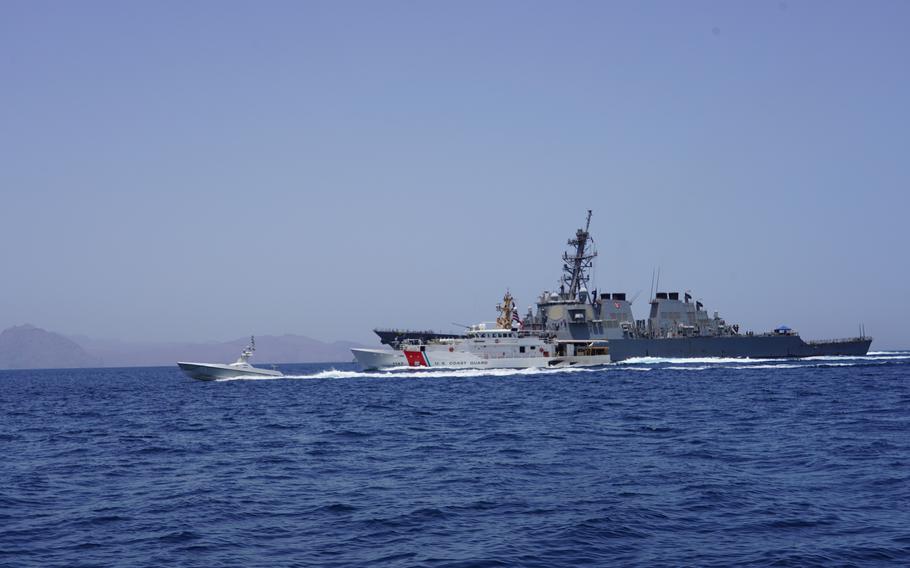
A screenshot of a video shows fast-attack boats from Iran’s Islamic Revolutionary Guard Corps navy swarming the Panama-flagged oil tanker Niovi in the Strait of Hormuz on May 3, 2023. (U.S. Navy)
The ship that set off a flurry of American naval patrols in the Middle East this summer was carrying nearly a million barrels of smuggled Iranian oil worth an estimated $56 million before it was seized, news reports and recently unsealed court documents said.
The filings, made in federal court in the District of Columbia, shed light on why the U.S. redirected the oil tanker Suez Rajan to Texas in April, prompting threats from Iran, and then seized the oil onboard in August.
Shortly after the U.S. confiscated the Suez Rajan as part of a sanctions enforcement operation, Iranian forces seized two oil tankers in the Strait of Hormuz and harassed others, U.S. officials said. This led to an uptick in U.S. patrols of that key waterway.
The court filings unsealed Aug. 30, first reported by The New York Times, include agreements in which the companies affiliated with the Marshall Islands-flagged Suez Rajan admitted to their part in a scheme to smuggle Iranian oil and evade U.S. sanctions.
Empire Navigation, based in the Marshall Islands and operating out of Greece, cooperated with law enforcement as part of a deferred prosecution agreement in April.
Its subsidiary, Suez Rajan Ltd., pleaded guilty to conspiracy to evade sanctions and agreed to pay $2.5 million, a document filed in April said.
While the U.S. has been seizing Iranian oil since 2019, the Suez Rajan case is unique because at the time of the transfer of oil, the ship was owned by a Los Angeles-based private equity firm, Oaktree Capital Management, which likely gave American prosecutors leverage, The Associated Press reported Thursday.

An unmanned surface vessel sails in front of U.S. Coast Guard fast response cutter USCGC Clarence Sutphin Jr. and U.S. Navy destroyer USS Paul Hamilton during a Strait of Hormuz transit May 23, 2023. ( Jeffrey Swope II/U.S. Coast Guard)
The scheme began with a ship known as the M/T Virgo turning off its location signals and taking on oil from a facility in Iran, court papers said, adding that the Virgo met up with the Suez Rajan near Singapore on Feb. 13, 2022.
A week earlier, the latter vessel had taken on about 4,000 barrels of legal oil from the ship CS Brilliance.
But the Suez Rajan then took on nearly 1 million barrels of oil from the Virgo, after which the crew falsified paperwork to make it seem as if all the oil had come from the Brilliance, the plea said.
After the nongovernmental organization United Against Nuclear Iran raised concerns of smuggling, the ship sat for months off the coast of Singapore before sailing for the Gulf of Mexico with seemingly no explanation, the AP reported at the time.
The tanker arrived off the coast of Texas on May 30, Reuters reported at the time.
The unsealed court filings revealed that Empire Navigation had made a deal with the U.S. to bring the Suez Rajan to Texas so the oil could be seized, The New York Times report said.
It sat off the Texas coast for several months because the U.S. was having difficulties finding a company willing to risk retaliation from Iran by unloading the oil, The New York Times said.
U.S. lawmakers urged President Joe Biden to offload the oil more quickly in a letter in mid-August that estimated that the cargo was worth $56 million.
The oil was offloaded in late August, The Associated Press reported, which led Iran’s Revolutionary Guard to warn that those involved in seizing the cargo “should expect to be struck back.”
Iran and the U.S. have accused each other of being a destabilizing force in the Middle East, which analysts say is locked in a shadow war between Tehran and Washington.
After the Suez Rajan was rerouted, Iran seized the Marshall Islands-flagged oil tanker Advantage Sweet in late April and the Panama-flagged Niovi in May.
The U.S. confiscated the Suez Rajan approximately five days before Iran took the Advantage Sweet, the maritime security company Ambrey told Reuters in a report on April 28.
The U.S. Navy said that these seizures were part of a pattern of Iranian harassment of civilian ships in the Middle East and that Tehran has harassed, attacked or seized 20 commercial vessels since 2021.
After the seizure of the Advantage Sweet and the Niovi, the U.S. announced an increase in patrols by ships and aircraft in the Strait of Hormuz.
Iran says the oil tankers were taken because of violations or legal disputes.
The U.S. has imposed sanctions on Iran for years in what it says is a bid to deny Tehran the funds to sponsor militant proxy groups in the region.
Iran regained the ability to sell its oil as part of a 2015 nuclear deal, but the sanctions returned in 2018, when former President Donald Trump unilaterally withdrew the U.S. from that agreement.